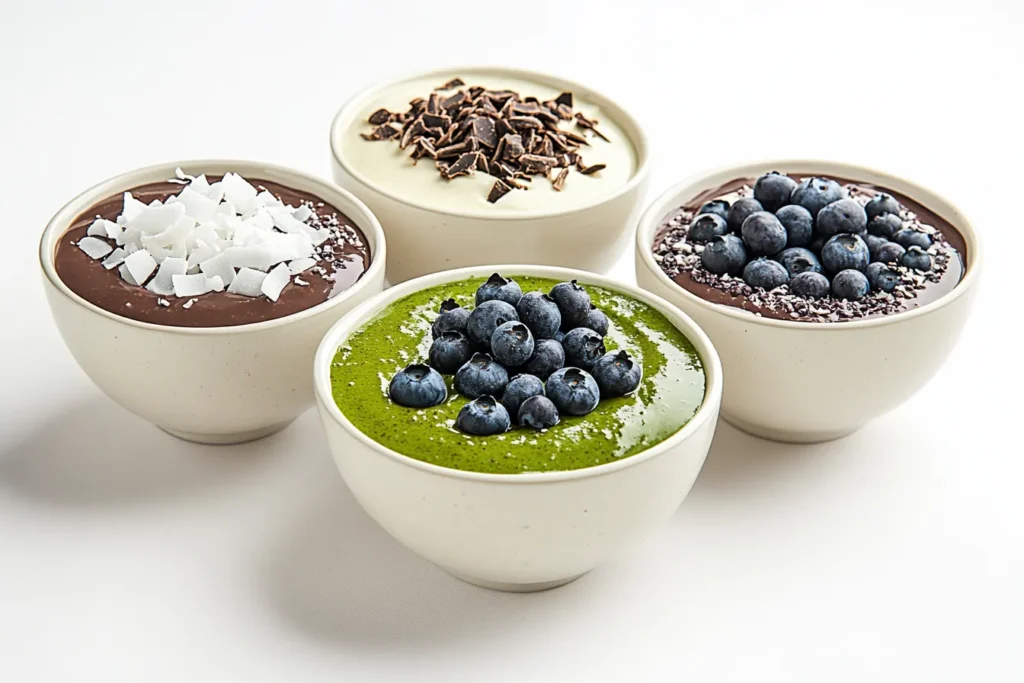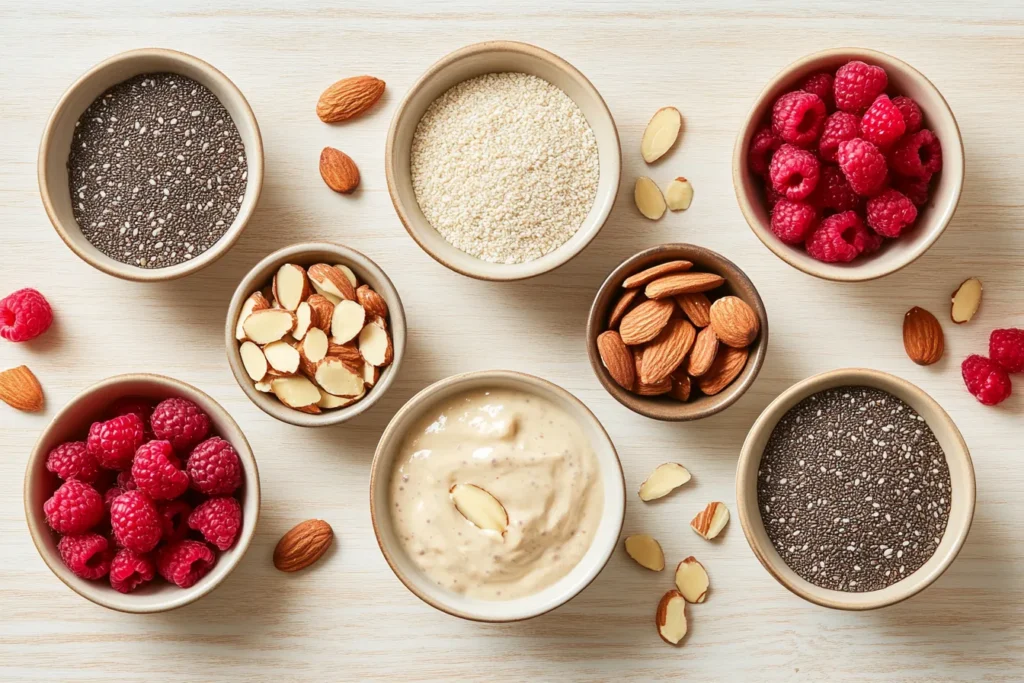Understanding Protein Pudding
What is Protein Pudding?
At its core, protein pudding for breakfast is a creamy, dessert-like dish enriched with a substantial amount of protein—often from whey, casein, or plant-based powders. But instead of indulging in sugary desserts, many people are reaching for this alternative to enjoy a guilt-free, high-protein breakfast.
Typically, protein pudding is made by blending Greek yogurt, protein powder, and ingredients like almond milk or chia seeds to thicken the mixture. Depending on your preference, you can also find store-bought versions in various flavors, such as chocolate, vanilla, and even matcha.
Nutritional Profile of Protein Pudding
Nutritional Information for Protein Pudding (Per 100g)
| Nutrient | Amount (Per 100g) |
|---|---|
| Calories | 120 kcal |
| Protein | 15 g |
| Carbohydrates | 8 g |
| Sugar | 2 g |
| Fats | 3 g |
| Fiber | 1 g |
| Sodium | 40 mg |
A serving of homemade protein pudding generally contains key nutrients. Learn how to make a delicious protein pudding recipe.:
- Calories: 150-250 (depending on ingredients)
- Protein Content: 15-30 grams
- Carbs: 10-20 grams (depending on the mix-ins)
- Fats: 5-10 grams (especially if you use healthy fat sources like nut butters)
When made thoughtfully, protein pudding can serve as a balanced option, rich in nutrients without excess sugars or unhealthy fats.
Benefits of Eating Protein Pudding for Breakfast
High Protein Content and Satiety
One of the main reasons people love protein pudding is its high protein content. Protein is known to increase satiety, helping you feel full for longer. This makes it ideal for those trying to avoid the mid-morning snack trap. Instead of reaching for processed pastries or sugary granola bars, protein pudding gives your body what it needs to curb cravings.
Also, since protein takes longer to digest, it helps stabilize your blood sugar levels—unlike carb-heavy breakfasts, which can cause spikes and crashes.
Quick and Convenient
Let’s face it—we’re all juggling busy schedules, and breakfast often gets rushed or skipped. Protein pudding can be prepped in advance and stored in the fridge for up to three days—similar to how you can batch-prepare protein coffee., making it a grab-and-go solution for hectic mornings.
You can also customize it easily! Whether you prefer chocolate, peanut butter, or a fruity twist with berries, protein pudding adapts to your taste buds and daily nutritional goals.
Versatility in Flavors and Toppings

One of the coolest things about protein pudding is its versatility. You can dress it up or keep it simple:
- Add fresh fruit like blueberries or bananas for natural sweetness.
- Sprinkle in chia seeds or flaxseeds for an extra fiber boost.
- Top it with crunchy granola or almond slivers for a satisfying texture.
This means you’re never stuck eating the same bland breakfast every day—it’s breakfast with flair!
Potential Drawbacks of Eating Protein Pudding for Breakfast
Added Sugars and Artificial Ingredients
While protein pudding can be healthy, it’s important to check the ingredient labels—especially for store-bought varieties. Many packaged protein puddings contain added sugars, artificial sweeteners, or preservatives to enhance flavor and shelf life.
Consuming too much added sugar, even at breakfast, can lead to energy crashes later in the day and may contribute to weight gain over time. So, if you’re opting for convenience, look for brands that list minimal ingredients and use natural sweeteners like stevia or monk fruit instead of high-fructose corn syrup or sucralose.
Caloric Content Considerations
Though protein pudding can be nutrient-dense, it’s easy to unintentionally go overboard on calories, especially with toppings. While almond butter, granola, and dried fruit are delicious additions, they can quickly add hundreds of extra calories to your breakfast if you’re not mindful.
For anyone with a weight loss goal, portion control is key. Measuring out your ingredients and toppings can make a significant difference. Instead of eyeballing, use a tablespoon to add nut butters and avoid overly generous portions of calorie-dense add-ins.
Digestive Concerns
Depending on your gut health and dietary habits, protein pudding may not sit well with everyone. Some people experience bloating or discomfort due to the types of protein used, such as whey or casein, which are dairy-based.
If you have lactose intolerance, you may want to use plant-based protein powders, such as pea, hemp, or rice protein, and pair them with non-dairy bases like almond milk or coconut milk. This swap can prevent stomach issues and make protein pudding a more enjoyable breakfast choice.
Additionally, thickening agents like chia seeds or flaxseeds, although healthy, can cause bloating if consumed in large amounts without enough water intake.
Comparing Protein Pudding to Traditional Breakfast Options
Protein Pudding vs. Oatmeal
Oatmeal is a classic breakfast staple known for its fiber content and heart-healthy benefits. However, on its own, it tends to be lower in protein unless you add protein-rich toppings like nuts, seeds, or Greek yogurt.
Comparison Snapshot:
- Oatmeal: Higher in carbs, great for sustained energy but lower in protein.
- Protein Pudding: Higher in protein, more filling, and customizable for lower carbs.
For those aiming to increase protein intake while maintaining satiety, protein pudding often wins. However, you can create a hybrid breakfast by adding a scoop of protein powder to your oats for the best of both worlds.
Protein Pudding vs. Smoothies
Smoothies are another go-to for breakfast lovers, especially those in a hurry. While smoothies can pack a punch with nutrients from fruits and veggies, they can also become calorie bombs if loaded with too many sugary fruits, juices, or nut butters.
Protein pudding, in contrast, offers a thicker, spoonable consistency that can help you slow down and feel more satisfied. Eating with a spoon instead of drinking can signal your brain that you’re having a full meal rather than a snack.
Protein Pudding vs. Eggs and Toast
Eggs and toast provide a balanced mix of protein and carbs, making them a common breakfast option for people who want a simple, savory meal. However, if you’re someone who prefers a sweeter start to the day, protein pudding can serve as a great alternative to sugary cereals or pastries.
Plus, protein pudding can easily be made dairy-free or vegan, whereas eggs are not suitable for plant-based diets.
How to Incorporate Protein Pudding into a Balanced Diet
Homemade vs. Store-Bought Protein Pudding
When it comes to making protein pudding part of your daily routine, the question often arises—should you make it at home or buy it from the store?
Homemade Protein Pudding:

- Pros: Full control over ingredients, customizable flavors, fewer preservatives.
- Cons: Requires prep time and measuring ingredients.
Making protein pudding at home not only helps you avoid artificial additives but also allows you to customize sweetness and texture. Furthermore, you have the freedom to choose a clean protein powder that suits your dietary needs. In addition, you can enhance the nutritional value by adding natural thickeners like chia seeds or Greek yogurt. Finally, for an even more balanced and flavorful meal, you can mix in healthy toppings such as berries, granola, or cacao nibs.
Store-Bought Protein Pudding:
- Pros: Convenient and ready-to-eat.
- Cons: Higher risk of added sugars, preservatives, and lower-quality protein sources.
If you’re opting for store-bought, look for brands that use high-quality protein sources (such as whey isolate or plant-based proteins) and contain no more than 5-7 grams of sugar per serving.
Enhancing Nutritional Value with Toppings

Protein pudding is like a blank canvas, and the right toppings can make all the difference in its flavor and nutrition. But here’s the catch—you’ll want to keep things balanced to avoid turning it into a calorie-heavy dessert.
Healthy Topping Ideas:
- For Fiber: Add chia seeds, flaxseeds, or fresh berries to support digestion and fullness.
- For Healthy Fats: Drizzle almond butter or sprinkle crushed walnuts to promote heart health.
- For Crunch: Try unsweetened coconut flakes, cacao nibs, or roasted pumpkin seeds for a satisfying bite—perfect alongside a protein cookie recipe.
- For Natural Sweetness: Use banana slices, diced mango, or a touch of honey.
By selecting nutrient-dense toppings, you can amplify the health benefits without unnecessary sugars or processed ingredients.
Portion Control and Frequency
Even healthy foods should be enjoyed in moderation. While protein pudding can be part of a balanced diet, eating it in large portions or multiple times a day may lead to macro imbalances.
- Ideal Portion Size: 1 cup or around 200-250 grams per serving.
- Frequency: 3-4 times a week, especially if you vary your breakfast options to include other nutrient sources like fruits, eggs, or smoothies.
By rotating protein pudding with other balanced breakfast options, you can prevent dietary monotony while ensuring you’re getting a wide range of vitamins and minerals from whole foods.
Expert Opinions on Protein Pudding for Breakfast
Dietitian Insights
Many dietitians agree that starting the day with protein can help improve satiety, stabilize blood sugar levels, and support muscle repair. According to nutrition experts, homemade protein pudding offers a great option because you can adjust the protein-to-carb ratio based on your goals.
Some dietitians, however, warn against using protein pudding as a sole breakfast option if it’s overly processed. Instead, they recommend adding fresh fruits and seeds to round out the meal.
Fitness Trainer Recommendations
Personal trainers often suggest protein pudding as a post-workout breakfast due to its protein-packed nature. It can help rebuild muscle and kickstart recovery after morning exercise. Fitness professionals emphasize combining fast-digesting protein, such as whey, with slower-digesting sources like Greek yogurt for sustained energy throughout the morning.
Frequently Asked Questions
Is protein pudding a good breakfast for weight loss?
Yes, protein pudding can be an excellent choice for weight loss when made with low-sugar ingredients and mindful portions. Its high protein content helps curb hunger and reduces the likelihood of overeating later in the day. To maximize its benefits, use unsweetened almond milk, low-fat Greek yogurt, or plant-based protein powders, and avoid calorie-heavy toppings like chocolate chips or sugary syrups.
Can I eat protein pudding every day?
Technically, yes—but moderation is key. While protein pudding is packed with nutrients, eating it daily without variation can lead to nutrient gaps. To keep things balanced, rotate your breakfasts with options like smoothies, eggs, or whole-grain oats to ensure you’re getting enough fiber, healthy fats, and micronutrients.
What are some healthy toppings for protein pudding?
Healthy toppings include fresh berries (like blueberries or raspberries), sliced bananas, unsweetened coconut flakes, chia seeds, and almond butter. If you’re craving crunch, sprinkle some roasted pumpkin seeds or cacao nibs. The goal is to add toppings that enhance the nutritional profile rather than turning the pudding into a dessert-like treat.
Can I make protein pudding at home? Absolutely! Just be sure to know how long protein pudding lasts in the fridge.
Absolutely! Making protein pudding at home is not only healthier but also allows you to customize the flavors and nutrients to fit your needs. A basic recipe includes protein powder, unsweetened almond or oat milk, Greek yogurt (or a dairy-free alternative), and optional thickeners like chia seeds. Blend the ingredients, let it chill in the fridge for 1-2 hours, and enjoy a creamy, protein-rich breakfast that’s tailored to you.
Conclusion
Protein pudding can be a fantastic breakfast option that ticks all the right boxes; in fact, it’s quick, filling, delicious, and adaptable to different dietary needs. Moreover, by carefully selecting your ingredients, controlling portion sizes, and adjusting how often you enjoy it, you can easily make this protein-rich treat a valuable part of a balanced morning routine. Consequently, incorporating protein pudding into your breakfast not only boosts your protein intake but also helps keep hunger at bay until your next meal. Whether you’re looking for a post-workout recovery meal or a convenient, satisfying breakfast, protein pudding is worth considering.
Remember, breakfast doesn’t have to be boring or complicated. In fact, it can be fun and delicious with the right choices. Moreover, with a bit of planning and some creativity, you can turn protein pudding into a healthy, satisfying meal.As a result, you’ll look forward to breakfast every morning and start your day with energy and focus.

